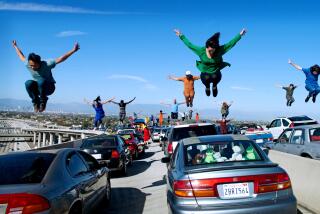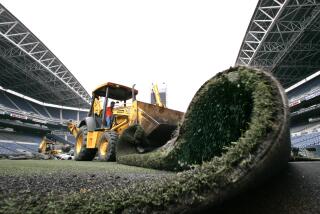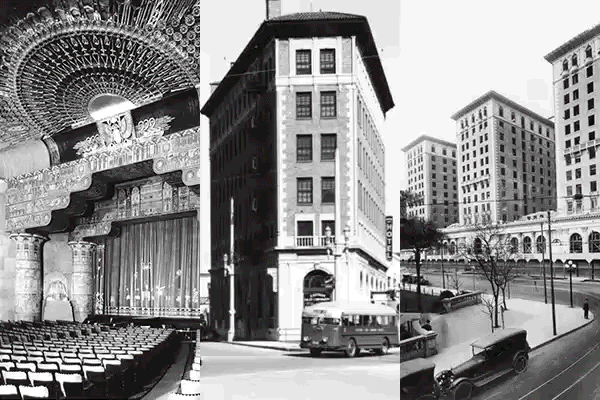Tee Time : Even Miniature Holes Hit It Big With Golfers
- Share via
Los Angeles’ first golf course is believed to have been the one constructed by Gen. John M. Baldwin on the old Rancho de Los Feliz, on land that is now Griffith Park.
Baldwin, during the Mexican-American War of 1847, had become the first American to occupy the rancho, and he built himself a mansion with private links. But during the great storm of 1884, the mansion was wrecked and washed through the golf course down the wild Los Angeles River to the sea.
Los Angeles’ newest golf course features a small tract home smack dab in the middle of the first fairway. The idea is to hit the golf ball through the front door, out the back door and have it land in a baby’s mouth. This will not win you a free game. The baby--a machine, really--spits the ball back.
Such is the first hole at newly unveiled Art Golf, the nine-hole miniature golf course built by artists at Los Angeles Contemporary Exhibitions.
It has come to this: Golfmania has gone avant-garde.
Any duffer in Los Angeles--home of the country’s largest municipal golf system--well knows the craziness that has seized the game. The National Golf Foundation says the number of golfers in the United States rose from 15.1 million in 1980 to 23.4 million in 1988. All of them, it sometimes seems, have tee times at the scores of public courses in Los Angeles County.
Bob Block, a card-carrying devotee of Los Angeles’ municipal golf system, says members of his foursome take turns every Monday getting up at 6 a.m. to phone for a weekend reservation. “Usually takes about 40 minutes,” Block said. “You need that instant redial button. Can’t play golf without one.”
This is especially true in the summer--when days are long, weather is fair, school is out, tourism is up and Tokyo is so hot and humid.
Tourists and immigrants from several Asian countries where golf has become a passion account for part of the traffic jam. Another popular theory links the golf boom to yuppies with knees ruined by jogging and racquetball.
What used to be a leisurely, pastoral pastime--”a good walk,” Mark Twain called it--is now a matter of hurry-up-but-mostly-wait. In 1986, the City Council introduced “go golf,” a system employing clocks and marshals to encourage slow players to speed up. The program has since been modified; it was determined that little can be done to speed up a fully jammed course.
Three of the city’s 12 courses--Rancho Park, Wilson and Harding--rank among the world’s busiest, each recording well over 100,000 rounds played annually. They are open 365 days a year. Inoue Kiyoshi, a Tokyo native who now lives in Los
Angeles, was standing recently on the practice putting green of the Wilson/Harding municipal courses at Griffith Park, just a pitching wedge from where Gen. Baldwin’s mansion once stood. He travels frequently to his hometown on business, and often entertains Japanese clients here. He also plays regularly with Block and two other partners.
“A good course in Tokyo costs about $250 to play,” said Kiyoshi, who was paying $12.50 for 18 holes at Wilson. “We need more golf courses.” It is a common lament.
Art Golf, running through July, may not be what Kiyoshi had in mind. But Phil Riggs, assistant manager at Wilson/Harding, said any course, even one in an art gallery, is a welcome addition. Devotees of miniature golf, who have seen dozens of putt-putts bulldozed to make room for condos and parking lots, may also find encouragement.
Question of Image
At $1, Art Golf is a bargain even by miniature golf standards. Golfers who try LACE’s links, tucked east of downtown on the aptly named Industrial Street, can expect a different type of aesthetic experience.
But there is a question of image. Will golfers, who have long suffered a stereotypical association with snobby country clubs and bright polyester pants, see Art Golf as a satire of the sport they take so seriously?
In any case, Art Golf aspires to be the thinking person’s putt-putt.
Steve Escandon, who collaborated with Terry Churchman in creating the first hole, said the tract home it features brings realism to miniature golf. “I can’t relate to windmills and castles,” he said. As the ball passes through the house, it triggers the sound of furniture falling, some odd music and a parent’s voice: “Get that thing out of here!”
Two Major Obsessions
“It’s about infamy in the suburbs,” Escandon explained. “It seems the two major obsessions of our generation--the thirtysomething crowd--are houses and babies.”
The work is titled “No Downpayment.” Par is 3.
Three artists made references to Zen philosophy in describing their creations. But Edmon Rodman chose a Soviet motif.
“Par-A-Stroka” features a putter-and-sickle emblem. The idea is to put the ball through Karl Marx’s head and sink it in Mikhail Gorbachev’s while avoiding the gulag. It’s a par 8.
“I saw one guy here who said he was a golfer,” Rodman said. “He said it looked like a tough hole. I told him socialism isn’t easy.”
Then comes the man in the Astroturf suit. Philo Northrup’s “Hypno-Hole” features a fairway covered with the images of American church-goers and a hypnotic recording tells you, “Relax . . . I love you . . . take off your clothes . . . give me your money.”
“Most of the obstacles here are psychological,” Northrup said. “Golf is a middle-American symbol. . . . We’re subverting that.”
Golf-Bashing Dismissed
Michael McCall, the creator of “Capt. Squid’s Beach Club Drive,” the ninth and final hole, dismisses such golf-bashing. A golfer himself, McCall said he tried to make his work a celebration of the sport. A net allows the golfer to take a full swing with a provided six-iron. The hole features a sloping Astroturf fairway with a sand trap and a pond.
“A lot of artists golf,” McCall said. “I can’t wait to bring my friends here and hit a bucket of balls.”
He said his goal was to approximate the experience of golf.
Still, the aesthetic appeal is different. And in the sprawl of Los Angeles, golf can provide moments of startling beauty.
One evening at Roosevelt, a nine-hole course in Griffith Park, a foursome had reached the eighth hole as dusk was turning to night. The eighth is a sloping dogleg right, flanked by woods on both sides. From the tee the fairway rises toward the distant dome of the Griffith Observatory. The idea is to drive the ball toward the dome and carry the rise, setting up a short iron to the green.
The light was fading, but the golfers were in no hurry.
A family of deer had come out of the woods and strolled across the fairway.


